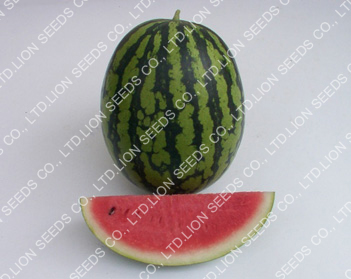
An attractive appearance Dragon type, crisp and very sweet. Fruit is semi-oblong in shape, 8-10 kg in weight, dark green stripes on green rind, thin but tough enough to ship long distance, red color flesh and special flavor. Maturity is 72-75 days from sowing.
DID YOU KNOW? Watermelon – (Citrullus lanatus, formerly C. vulgaris), succulent fruit of the gourd family (Cucurbitaceae), native to tropical Africa, but under cultivation on every continent except Antarctica. Its vines grow prostrate, with branched tendrils, deeply cut leaves, and flowers borne singly in the axil of a leaf. Each light yellow flower produces either pollen or fruit. The sweet, juicy flesh may be reddish, white, or yellow. Flesh colour, shape of the fruit, and thickness of the rind depend on the variety. Weight varies from 1 to 2 kg (2.5 to 5 pounds) to 20 kg or more. The number of fruits per vine varies from 2 or 3 to 15.
The history of watermelons is a long one; there is a Sanskrit word for watermelon, and fruits are depicted by early Egyptian artists, indicating an antiquity in agriculture of more than 4,000 years.
Watermelon contains vitamin A and some vitamin C. It is usually eaten raw. The rind is sometimes preserved as a pickle.
The history of watermelons is a long one; there is a Sanskrit word for watermelon, and fruits are depicted by early Egyptian artists, indicating an antiquity in agriculture of more than 4,000 years.
Watermelon contains vitamin A and some vitamin C. It is usually eaten raw. The rind is sometimes preserved as a pickle.
